![]()
![]()
![]()
Use LEFT and RIGHT arrow keys to navigate between flashcards;
Use UP and DOWN arrow keys to flip the card;
H to show hint;
A reads text to speech;
43 Cards in this Set
- Front
- Back
|
What chronic pathologies can cause oxidant stress to erythrocytes?
|
1. hypercholesterolemia
2. hypertension 3. diabetes |
|
|
What drugs/toxins can cause high levels of erythrocyte oxidative stress?
|
antimalarial drugs such as primaquine
|
|
|
What is the important amino acid in glutathione that has a thiol side-chain?
|
Cysteine
|
|
|
What effect does oxidizing a thiol residue have on enzyme function?
|
Inactivates the enzyme, and oxidizing a enzyme too much results in permanent activation of the enzyme
|
|
|
What is the function of superoxide dismutase?
|
Removes free oxygen radicals from circulation by turning them into H2O2, so the higher the superoxide dismutase concentration the more free radicals are removed from circulation
|
|
|
Why is H2O2 a problem?
|
B/c in the presence of Fe(II) H2O2 is cleaved to form OH* radicals which are extremely dangerous
|
|
|
How is H2O2 broken down in RBCs?
|
By catalase which breaks H2O2 into H2O/O2
|
|
|
What superoxide dismutase mutation is present in RBCs?
|
SOD1 b/c it is present in the cytoplasm, whereas SOD is present in the mitochondria and extracellular in SOD2 and SOD3 respectively
|
|
|
What does SOD1 mutation cause?
|
Cytoplasmic and caused by Cu and Zn cofactors which cause amylotropic lateral sclerosis 1
|
|
|
What enzyme uses glutathione to oxidize H2O2 thus providing another pathway to remove H2O2?
|
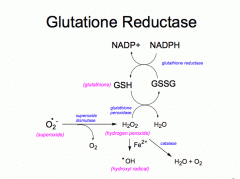
Glutathione peroxidase
|
|
|
What enzyme regenerates glutathione, GSH using NADPH?
|
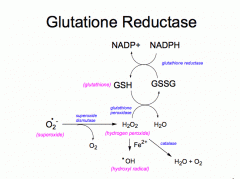
Glutathione reductase
|
|
|
What can cause early aging due to decreased activity of dismutase and catalase?
|
Inability to remove H2O2
|
|
|
What effect do oxidized carbohydrates for aldehydes have?
|
React w/ neutrophils on proteins and nucleic acids
|
|
|
What effect do oxidizing lipids have?
|
alter membrane properties and react w/ proteins and nucleic acids
|
|
|
What pathway generates NADPH that is used to remove ROS's?
|
Pentose Phosphate Pathway -aka- "hexose monophosphate shunt"
|
|
|
What is the importance of ribose-5-phosphate?
|
Important in DNA synthesis
|
|
|
Where is ATP used in the pentose phosphate pathway?
|
NO ATP IS USED!!!
|
|
|
What is the rate-limiting reaction in the pentose phosphate pathway?
|
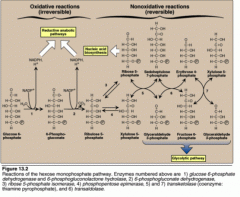
G6P dehydrogenase, which is also the first step
|
|
|
What steps in the PPP generate NADPH?
|
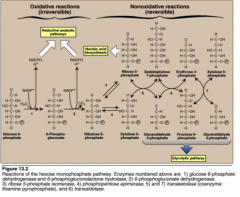
1. G6P dehydrogenase/ 6-phosphogluconolactone hydrolase
2. 6-phosogluconolactone hydrolase |
|
|
What glycolytic intermediates are generated by the PPP?
|
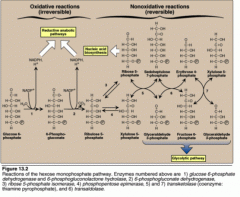
glyceraldehyde-3-phosphate and fructose-6-phosphate
|
|
|
What intermediate that is generated by the PPP can be used as a glycolytic intermediate or can be recycled into the PPP to make NADPH or ribose-5-phosphate?
|
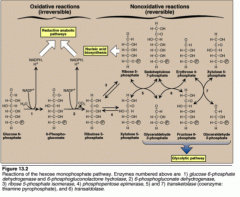
fructose-6-phosphate
|
|
|
What intermediate generated by the PPP will only go forward through glycolysis?
|

Glucose-3-phosphate
|
|
|
What intermediates that are generated by the PPP are not useful and must be converted to other metabolites in order to be useful?
|
1. xylulose 5 phosphate,
2. sedoheptulose 7 phosphate 3. ribose 5 phosphate |
|
|
How do cells w/ Glucose 6 phosphate dehydrogenase deficiency make ribose 5 phosphate?
|
By going backwards through the PPP using glycolytic intermediates glyceraldehyde 3 phosphate and fructose 6 phosphate
|
|
|
What is the rate-limiting step in the PPP?
|
Glyceraldehyde 6 phosphate dehydrogenase
|
|
|
What symptom is present in pts w/ the G6PD Variant?
|
hereditary non spherocytic hemolytic anemia
|
|
|
What is the interaction that can happen b/e the active site of heme and nitric oxide?
|
NO can interact w/ the active site of the RBC to create a molecule of nitrate, which oxidizes the Fe group on the RBC to the Fe(III) state
|
|
|
What is heme Fe(III) called? what are this molecule's special characteristics?
|
Methemoglobin, which cannot bind oxygen
|
|
|
What molecule is generated by interaction of superoxide and nitric oxide?
|
A short-lived species called peroxide nitrite (ONOO) which can cause huge damage during its lifespan
|
|
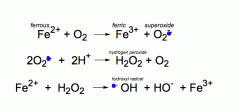
What reaction does superoxide dismutase accelerate?
|
The middle reaction
|
|
|
What is the good and the bad about vitamin C (Ascorbic acid)?
|
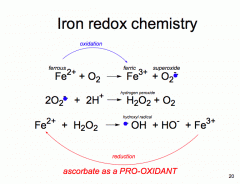
It is an antioxidant, which is GOOD but it also converts Fe(III) to Fe(II) which is good and bad, its good b/c it reduces the Fe BUT it is bad b/c it breaks Fe(II) can react w/ H2O2 to generate OH* radicals which also creates Fe(III) AGAIN which then goes on and is reduced by Vit. C to Fe(II) repeating the cycle of death
So if you have a dz that causes Fe(III) to be released into circulation it can react w/ ascorbic acid and cause this cycle |
|
|
What causes old RBCs to be recognizable by the spleen?
|
Damage to RBC membranes caused by interaction w/ free radicals
|
|
|
What enzyme converts methemoglobin to hemoglobin?
|
Methemoglobin reductase
|
|
|
What cofactor does methemoglobin reductase require to function?
|
NADH
|
|
|
What does NO react with in blood?
|
oxidized hemoglobin in the RBC to form nitrite, which is part of normal detoxification of nitric oxide
|
|
|
What slows down the NO breakdown to nitrite w/in RBCs?
|
The membrane of RBCs and the packaging of iron w/in the globin molecule so this slows down the creation of methemoglobin
|
|
|
Where do RBCs get the NADH used to breakdown methemoglobin?
|
From glycolysis, but pyruvate conversion to lactate also uses NADH to regenerate NAD+ for glycolysis. SO the RBC must decide whether to have NADH used to make lactate or to use it to remove methemoglobin
|
|
|
What is the function of methylene blue?
|

Methylene blue is reduced by NADPH to breakdown methemoglobin and create leukomethylene blue
|
|
|
What side-effect of methylene blue can cause anemia?
|
If a pt cannot make NADPH then methylene blue will reverse and convert normal Hb(FeII) to methemoglobin and leukomethylene blue so anemia will be accelerated
Pts that cannot make NADPH are pts that have G6P dehydrogenase deficiencies |
|
|
Why do Fava beans cause anemia?
|
Fava beans act like methylene blue, so pts who have G6P dehydrogenase deficiencies will cause hemoglobin to be converted to methemoglobin, causing anemia
|
|
|
What reaction commits glucose to go down glycolysis?
|
PFK which converts fructose-6-phosphate to fructose-1,6-bisphosphate
|
|
|
How does the RBC decide whether to use glucose to go down the PPP or through glycolysis?
|
PFK is the commiting step of glycolysis, but when it binds to band 3 protein it deactivates the PFK. So G6P will go through the PPP and glucose will be used for its antioxidant properties. this occurs when oxygen is bound.
When hemoglobin is unbound PFK is not bound to band 3 protein and so glucose goes through glycolysis and not the PPP. So a low-oxigenation state glucose goes through glycolysis, but in a high-oxidative state there is the possibility of making free-radicals and so glucose goes through the PPP to generate free-radical fighting chemicals. |
|
|
If you don't have NADPH what will build up and cause cellular damage?
|
OH*
|

